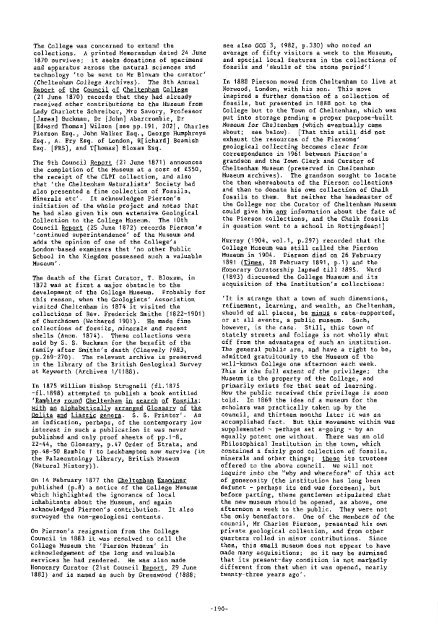Number 5 - Geological Curators Group
Number 5 - Geological Curators Group
Number 5 - Geological Curators Group
Create successful ePaper yourself
Turn your PDF publications into a flip-book with our unique Google optimized e-Paper software.
The College was concerned to extend thecollections. A printed Memorandum dated 24 June1870 survives: it seeks donations of specimensand apparatus across the natural sciences andtechnology 'to he sent to Mr Bloxam the curator'(Cheltenham College Archives). The 8th AnnualReport of the Council of Cheltenham Colleee(21 June 1870) records that they had alreadyreceived other contributions to the Museum fromLady Charlotte Schreiher, Mrs Savory, Professor[James] Buckman, Dr [John] Abercramhie, Dr[Edward Thomas] Wilson [see pp.191, 2021, CharlesPierson Esq., John Walker Esq., George HumphreysEsq., A. Fry Esq. of London, R[ichard] BeamishEsq. [FRS], and T[homas] Bloxam Esq.The 9th Council (21 June 1871) announcesthe completion of the Museum at a cost of £550,the receipt of the CLPI collection, and alsothat 'the Cheltenham Naturalists' Society hadalso presented a fine collection of Fossils,Minerals etc'. It acknowledges Pierson'sinitiation of the whole project and notes thathe had also given his own extensive <strong>Geological</strong>Collection to the College Museum. The 10thCouncil (25 June 1872) records Pierson's'continued superintendence' of the Museum andadds the opinion of one of the College'sLondon-based examiners that 'no other PublicSchool in the Kingdom possessed such a valuableMuseum'.The death of the first Curator, T. Bloxam, in1872 was at first a major obstacle to thedevelopment of the College Museum. Probably forthis reason, when the Geologists' Associationvisited Cheltenham in 1874 it visited thecollections of Rev. Frederick Smithe (1822-1901)of Churchdown (Wethered 1901). He made finecollections af fossils, minerals and recentshells (Anon. 1874). These collections weresold by S. S. Buckman far the benefit of thefamily after Smithe's death (Cleevely 1983,pp.269-270). The relevant archive is preservedin the library of the British <strong>Geological</strong> Surveyat Keyworth (Archives 1/1188).In 1875 William Bishop Strugnell (£1.187541.1898) attempted to publish a hook entitled'Rambles round Cheltenham in af Fossils;-- with an alohaheticallv arransed Glossary of theOolite a Liassic genera. S. S. Printer'. Asan indication, perhaps, of the contemporary lowinterest in such a publication it was neverpublished and only proof sheets of pp.1-8,22-44, the Glossary, p.47 Order of Strata, andpp.48-50 Ramble 1 to Leckhampton now survive (inthe Palaeontology Library, British Museum(Natural History)).On 14 February 1877 the Cheltenham Examinerpublished (p.8) a notice of the College Museumwhich highlighted the ignorance of localinhabitants about the Museum, and againacknowledged Pierson's contribution. It alsosurveyed the non-geological contents.On Pierson's resignation from the CollegeCouncil in 1883 it was resolved to call theCollege Museum the 'Pierson Museum' inacknowledgement of the long and valuableservices he had rendered. He was also madeHonorary Curator (21st Council M, 29 June1883) and is named as such by Greenwood (1888;see also GCG 3, 1982, p.330) who noted anaverage of fifty visitors a week to the Museum,and special local features in the collections offossils and 'skulls of the stone period'!In 1888 Pierson moved from Cheltenham to live atNorwood, London, with his son. This moveinspired a further donation of a collection offossils, but presented in 1888 not to theCollege but to the Town of Cheltenham, which wasput into storage pending a proper purpose-builtMuseum for Cheltenham (which eventually cameabout: see below)., L[That this still did notexhaust the resources of the Piersons'geological collect in^ becomes clear fromEorreipondence in 1961 between Pierson'sgrandson and the Town Clerk and Curator ofCheltenham Museum (preserved in CheltenhamMuseum archives). The erandson soueht to locatethe then whereabouts of-the pierson-collectionsand then to donate his own collection of Chalkfossils to them. But neither the headmaster ofthe College nor the Curator of Cheltenham Museumcould give him information about the fate ofthe Pierson collections, and the Chalk fossilsin question went to a school in Rattingdean!]Murray (1904, vol.1, p.297) recorded that theCollege Museum was still called the PiersonMuseum in 1904. Pierson died on 26 February1891 (Times, 28 February 1891, p. 1) and theHonorary <strong>Curators</strong>hip lapsed till 1895. Ward(1893) discussed the College Museum and itsacquisition of the Institution's collections:'It is strange that a town of such dimensions,refinement, learning, and wealth, as Cheltenham,should of all places, be minus a rate-supported,or at all events, a public museum. Such,however, is the case. Still, this town ofstately streets and foliage is not wholly shutoff from the advantages of such an institution.The general public are, and have a right to be,admitted gratuitously to the Museum of thewell-known College one afternoon each week.This is the full extent of the privilege; theMuseum is the property of the College, andprimarily exists for that seat of learning.How the public received this privilege is soontold. In 1869 the idea of a museum for thescholars was practically taken up by thecouncil, and thirteen months later it was anaccomplished fact. But this movement within wassupplemented - perhaps set a-going - by anequally potent one without. There was an oldPhilosophical Institution in the town, whichcontained a fairly good collection of fossils,minerals and other things; its trusteesoffered to the above council. We will notinquire into the "why and wherefore" of this actof generosity (the institution has long beendefunct - perhaps its end was foreseen), hutbefore parting, these gentlemen stipulated thatthe new museum should be opened, as above, oneafternoon a week to the public. They were notthe only benefactors. One of the members of thecouncil, Mr Charles Pierson, presented his ownprivate geological collection, and from otherquarters rolled in minor contributions. Sincethen, this small museum does not appear to havemade many acquisitions: so it may be surmisedthat its present-day condition is not markedlydifferent from that when it was opened, nearlytwenty-three years ago'.
















